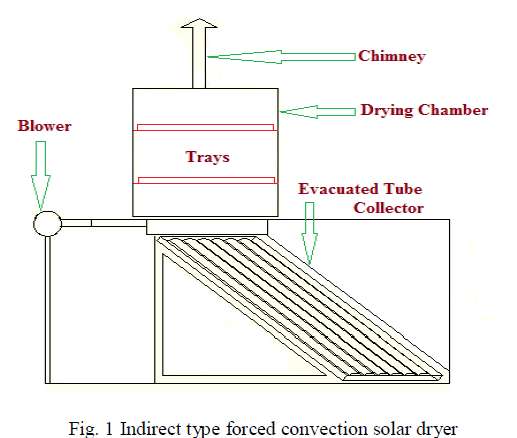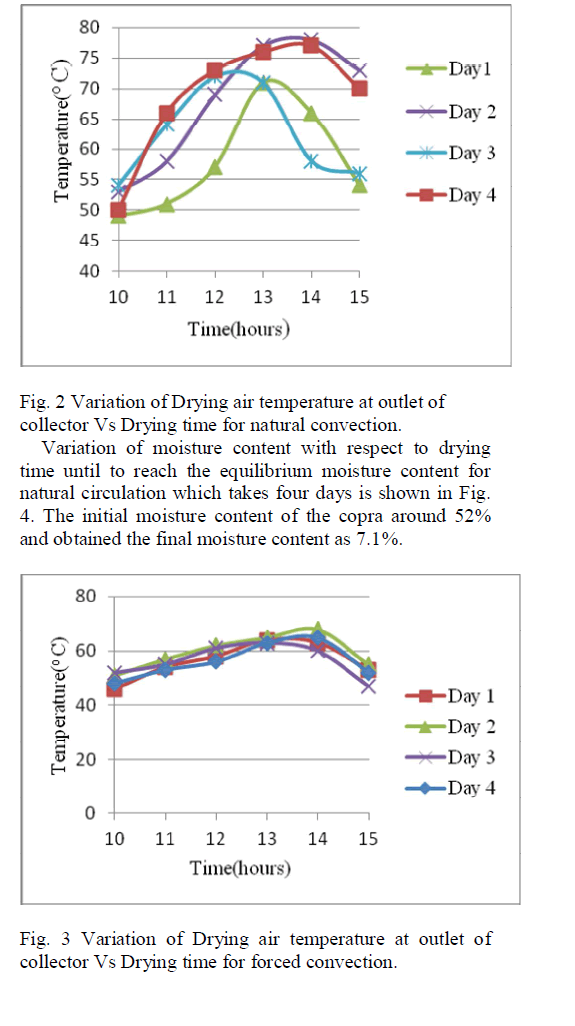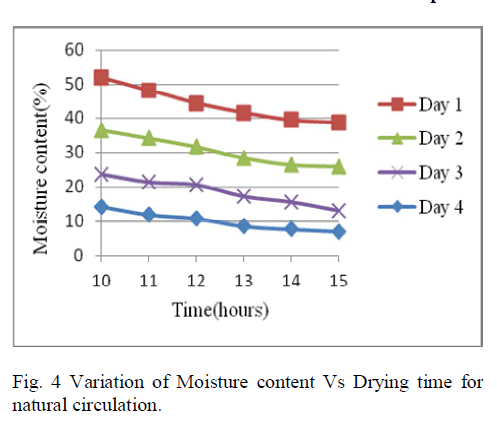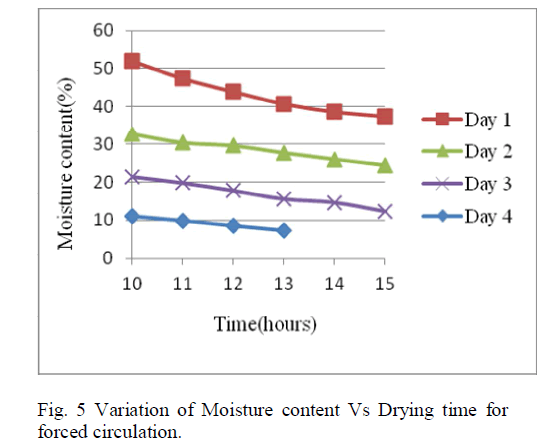ISSN ONLINE(2319-8753)PRINT(2347-6710)
ISSN ONLINE(2319-8753)PRINT(2347-6710)
| T.Rajagopal1, S.Sivakumar2, R.Manivel3 Department of Mechanical Engineering, Kumaraguru College of Technology, Coimbatore, india |
| Related article at Pubmed, Scholar Google |
Visit for more related articles at International Journal of Innovative Research in Science, Engineering and Technology
An indirect type forced convection solar dryer is fabricate with the components like evacuated tube collector, drying chamber and blower. The performance of the designed drier is evaluated by carrying drying experiments with copra at Coimbatore district Tamilnadu, India. A short survey of these showed that applying the forced convection solar dryer not only significantly reduced the drying time but also resulted in many improvements in the quality of the dried products. Solar drying of copra is carried for forced convection and is compared with natural convection solar drying. The temperature of the drying chamber ranges from 49ºC to 78ºC for natural and forced convection while the ambient temperature ranges from 28ºC to 32ºC. Initial moisture content of copra ranges from 51.7% to 52.3% and the final moisture content obtained about 7 to 8%. The forced convection solar dryer takes less time than the natural convection solar dryer to attain the equilibrium moisture content. Solar drying copra obtained was free from smoke, dust, bird and rodent damage
KEYWORDS |
| Forced convection, Evacuated tube Collector, Moisture content. |
I. INTRODUCTION |
| Preservation of fruits, vegetables, and food are essential to keeping them for a long time without deterioration in the quality of the product. The more number of process technologies have been employed on an industrial scale to preserve food products; the important ones are canning, freezing, and dehydration. Among these, drying which is suitable for developing countries with low-temperature and less thermal processing facilities. It offers a most effective and practical way of preservation to reduce losses during postharvest and offset the shortages in supply. Drying is a simple process of removing moisture from a product in order to reach the equilibrium moisture content and is an energy intensive operation. The main objective of drying apart from extended storage life can also improve the quality, ease of handling, further processing and is probably the oldest method of food preservation practiced by humankind. |
| India stands as the third position in the world for largest coconut-producing country. Copra is one of the major traditional products processed from coconuts. Fresh coconut contains a moisture content of about 52% (wet basis), which should be reduced down to about 7% by drying in order to concentrate the oil content. On an average, 5–7 coconuts are essential to produce 1 kg of copra, although this depends on the grade of product. The traditional methods followed in India are sun and kiln drying. They produce poor-quality copra and also take time to attain the equilibrium moisture content. In kiln drying, smoke has direct contact with the coconut and result as high-quality copra is not produced due to smoke deposits may form polycyclic aromatic hydrocarbons in the copra [1]. Sun drying takes about 7 days and if the weather is rainy the copra obtained will be contaminated with fungi which produce a grey rancid product. Moreover sun drying requires more space, is labour intensive and there can be produce low quality copra from deposits of dirt and dust. Also, microorganisms can cause rancidity, increase the acid content, and reduce the amount of oil extracted from the product resulting in low-quality coconut oil. The oil extracted from poor-quality copra also requires additional refinement to meet international standards. Several experimental and theoretical studies have been reported on the development of various types of solar driers for drying agricultural products [2]. |
| Drying plays a major role in which the free water molecules are removed leaving the essential bound water molecules. The ancient method used to preserve food is natural sun drying. But natural sun drying has many disadvantages such as uncontrolled drying, contamination by birds, insects and dust, climatic adversities etc. The quality of the product is found to be less and cannot be exported. It also requires more labour and the process is found to be slow. The main objective of the present work was to improve the quality of copra produced in a forced convection solar dryer. But it has been reported that the efficiency of evacuated tube collector is very high as compared to the efficiency of flat plate collectors. However, the some experimental works have been taken on solar evacuated tube dryers [3]. So an attempt has been made to design and construct a novel solar dryer with evacuated tube collectors and study its performance on copra in the district of Coimbatore, Tamilnadu, India. |
II. MATERIALS AND METHODS |
| A. Measuring Instruments and Devices |
| A digital anemometer is used to measure ambient temperature and wind velocity. A solarimeter is a pyranometer of silicon pn junction type of measuring device used to measure combined direct and diffuse radiation. The samples are weighed in hourly basis using a digital electronic balance with an accuracy of one milligram. The humidity of the ambient air was calculated by using psychometric chart with the help of measured wet and dry bulb temperatures recorded by respective mercury thermometers during the experiments. |
| B. Experimental Setup |
| The indirect type forced convection solar dryer is mainly constructed with four essential features namely, the blower, the evacuated tube collector, the drying chamber and the chimney. Fig. 1 shows the section of the solar dryer. The drying chamber is made of stainless steel sheets of thickness 27.5mm and insulated on all sides with rock wool slab to prevent a loss of heat. It consists of two perforated trays as top and bottom tray to place the product to be dried. It consists of six evacuated tube collectors with a copper header for transfer of heat to the inlet air drying collector. The double layer glass evacuated tube collector is about 1.6mm thickness and the gap between the glass tubes is evacuated. Heat loss due to convection, conduction and radiation is thus minimized and it can withstand high temperature due to this technology. The collector is placed along N-S direction, facing south so as to track maximum solar radiation during the day time. The evacuated tube collector is used as air heater which connected to the drying collector with the help of EPDM (Ethylene Propylene Diene Monomer) rubber hose. The hot air from the drying collector outlet is connected to the inlet of drying chamber. The blower is attached at the inlet of the drying collector for conducting the experiment of forced convection. |
 |
| C. Experimental Procedure |
| Broken copra’s are uniformly spread in the trays and are kept inside the chamber for solar drying. In the designed solar dryer, air is blown into the evacuated tube collector with the help of the external device blower. The solar radiation falling on the collector, the collector gets heated up and transfers heat to the air flowing through the drying collector. This hot air enters the inlet of the drying chamber where copra is loaded in two trays. The moving hot air evaporates the water content (moisture) of the copra under the basic mechanism of removal of moisture from the surface of the product to the surrounding followed by the removal of moisture from inside the product to the surface [4]. The velocity of the air at the tray was adjusted by using a control valve. During the experiments, temperatures at various locations in the solar collector and the drier chamber, ambient dry and wet bulb temperatures were measured at hourly intervals. The relative humidity of air was calculated from measured wet and dry bulb temperatures using a psychometric chart. After the moisture content was reduced to 40%, the copra kernels were scooped from the shells and dried further without shells. Moisture contents were determined by using Eq. (2). Experiments were only conducted during daylight hours. The readings are taken on hourly basis from 10.00am to 3.00pm until copra attained equilibrium moisture content. |
| D. Analytical Calculation |
| 1) Determination of Moisture Loss |
| Moisture loss of drying product copra every hour using the below formula [4], |
| ML = Mt - Md |
| (1) The initial Mt, and final mass Md, of the samples were recorded with the help of electronic balance. |
| 2) Determination of Moisture Content |
| The quantity of moisture present in a material can be represented on wet basis and expressed as percentage. The moisture content, Mwb, on wet basis was calculated by using Eq. (2). The procedure was repeated for every one hour interval till the end of drying. |
 |
III. RESULTS AND DISCUSSION |
| Temperature variations of the designed solar dryer natural circulation for four days on hourly basis from 10.00a.m to 3.00pm during the experimentation for natural circulation are shown in Fig.2. The maximum temperature of 78oc was observed and average temperature recorded at the outlet of the drying collector was 64 oc. It is observed that the temperature inside the drying chamber is higher during the mid-noon time. |
| The variation of air temperature at outlet of collector with respect to drying time on hourly intervals for different days with forced convection is shown in Fig.3. The minimum and maximum temperature was recorded during the forced convection is 48oc and 68oc respectively. The temperature variation is due to the change in solar radiation intensity which is measured by using the instrument pyranometer. |
 |
 |
| The variation of moisture content and drying time for forced convection is shown in Fig.5. The drying time taken by the designed solar dryer with forced convection to reach the equilibrium moisture content of copra is less than the natural convection. The initial moisture content of the drying product was 52% and reached the final moisture content as 7.3% which comes under the equilibrium moisture content. The forced convection has been conducted with blower with velocity of 1m/s in the inlet of drying chamber. The moisture content is reduced in the initial stages well as compared to the lower stage to reach the equilibrium moisture content. The drying rate decrease with increase the drying time during the experimental observation. |
 |
IV. CONCLUSION |
| In this experimental study, the drying of copra was investigated under the two different modes as natural and forced convection. The indirect type forced convection solar dryer with evacuated tube collector generates air temperature higher inside the chamber and enhance drying rate thereby reducing the drying time required to dry a product. The time taken by the solar dryer with forced convection to reach desired moisture content is less than the time required in natural convection. As the solar dryer using evacuated tube collector can perform better even during cloudy days and winter season. The designed indirect type solar dryer utilized the more solar thermal energy as a result obtained as reducing the time required to dry the copra and also improves the quality of the drying product. |
References |
|